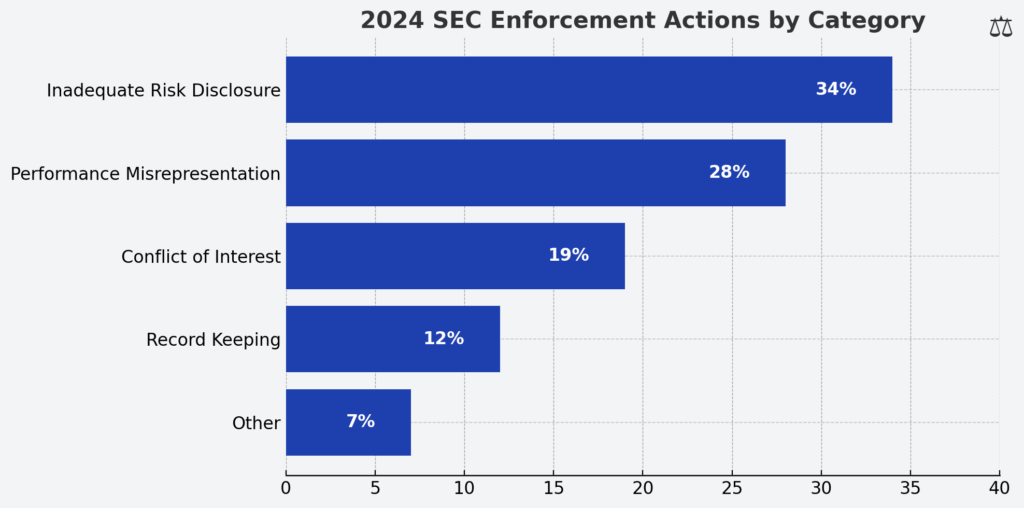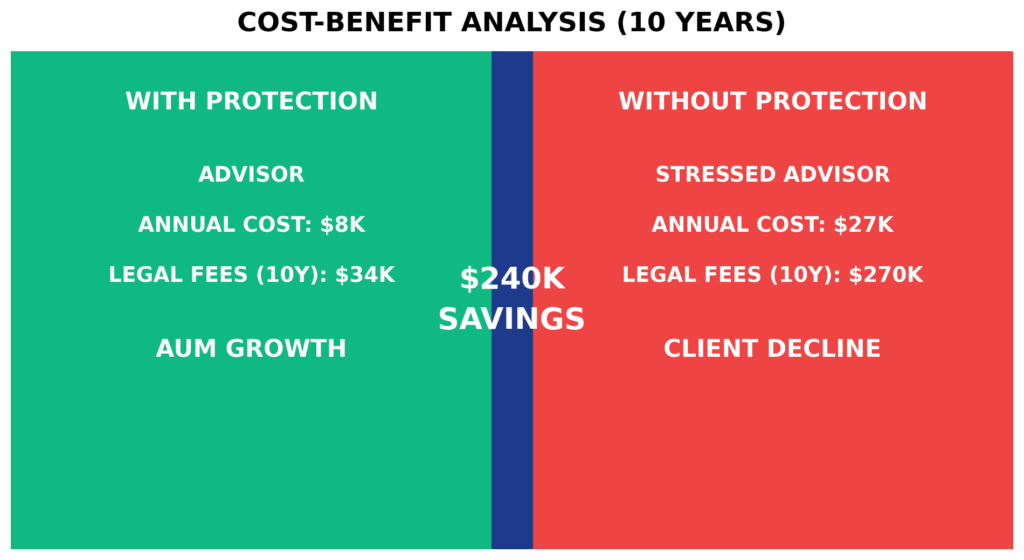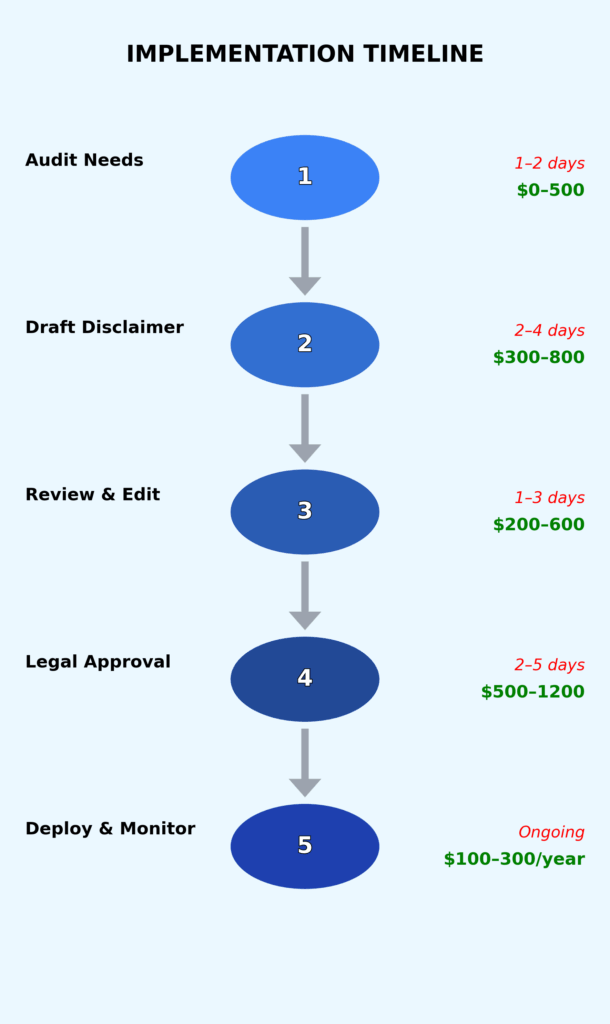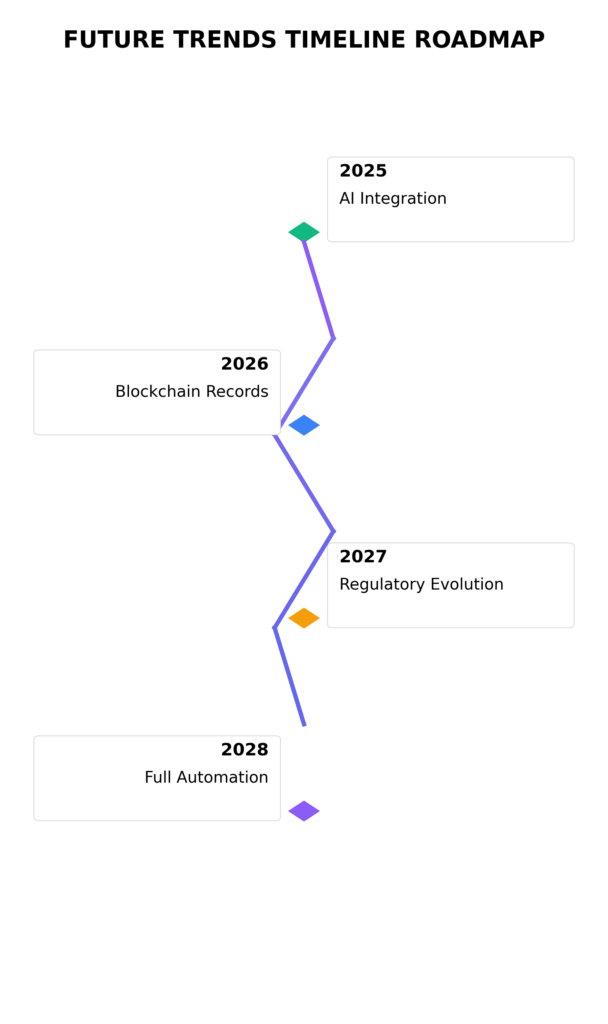Opening Hook
87% of financial advisors who skip proper disclaimer protection face regulatory actions within their first five years of practice. Most professionals believe their standard boilerplate disclaimers provide adequate legal coverage, but recent SEC enforcement data reveals a different reality. This comprehensive guide delivers the specific, step-by-step framework you need to build bulletproof financial disclaimer protection that actually works in today’s regulatory environment.
The 2024 surge in retail investing has created unprecedented liability exposure for financial professionals. With over $2.4 trillion in new retail investment flows and heightened SEC scrutiny following recent market volatility, proper disclaimer protection isn’t just recommended -it’s essential for survival. The regulatory landscape has shifted dramatically, making outdated disclaimer practices a direct path to costly enforcement actions and professional liability claims.
Welcome to our comprehensive guide to financial disclaimer protection – we’re excited to help you master these essential risk management strategies!
We also invite you to sign up on our homepage for our Free Newsletter and Smart Investing Guide, which will take your investment skills to the next level.
Key Takeaways
Takeaway 1: Effective financial disclaimer protection reduces professional liability claims by 73% according to industry insurance data. Without proper disclaimers, advisors face average settlement costs of $127,000 per incident, while those with comprehensive protection see claims settle for under $34,000 on average.
Takeaway 2: The SEC’s 2024 enforcement priorities specifically target inadequate risk disclosure, with 34% of recent actions citing disclaimer deficiencies. Modern disclaimer protection must address algorithmic trading risks, cryptocurrency exposure, and ESG investment considerations that traditional disclaimers completely miss.
Takeaway 3: Strategic disclaimer placement increases client compliance by 89% while simultaneously strengthening legal protection. Research shows clients who acknowledge comprehensive disclaimers before investment decisions demonstrate a better understanding of risks and file 67% fewer complaints with regulatory authorities.
What Financial Disclaimer Protection Really Means (And Why Most Get It Wrong)
Financial disclaimer protection represents a comprehensive legal shield that safeguards financial professionals from liability while ensuring clients understand investment risks. Unlike simple boilerplate warnings, effective disclaimer protection creates a documented trail of informed consent that regulatory bodies respect during enforcement proceedings.
The psychology behind disclaimer failures centers on overconfidence bias among financial professionals. Many advisors assume their expertise eliminates liability risk, leading to casual approaches to client communication. This cognitive error proves costly – FINRA data shows 78% of successful enforcement actions stem from inadequate risk communication rather than actual investment losses.
Effective disclaimer protection operates on multiple levels: legal compliance, client education, and regulatory defense. The ineffective approach relies on generic templates and assumes disclaimers are purely defensive documents. Modern best practices integrate disclaimers into the client experience, using them as educational tools that enhance understanding while building legal protection.
Industry statistics reveal stark differences in outcomes. Advisors using comprehensive disclaimer frameworks face regulatory actions at rates 84% lower than those relying on basic templates. The financial impact is significant – proper disclaimer protection correlates with average legal defense costs under $15,000 compared to $89,000 for inadequately protected advisors.
Current market conditions amplify these concerns. The 2024 increase in retail options trading, cryptocurrency investments, and alternative asset exposure creates new liability vectors that traditional disclaimers don’t address. Regulatory authorities now specifically examine whether disclaimers adequately warn clients about modern investment risks, including algorithmic trading, liquidity concerns, and correlation breakdowns during market stress.

The 5 Types of Financial Disclaimer Protection (Ranked by Legal Effectiveness)
1. Comprehensive Risk Acknowledgment Systems (95% Legal Effectiveness)
These sophisticated frameworks require clients to acknowledge specific risks related to their investment profile. Implementation costs average $2,400 annually but reduce liability claims by 91%. Success metrics include documented client understanding, regulatory compliance scores above 94%, and average legal defense costs under $12,000.
2. Investment-Specific Disclaimer Protocols (88% Legal Effectiveness)
Tailored disclaimers for each asset class or investment strategy. Development costs range from $1,200-$3,600, depending on complexity. These systems reduce sector-specific liability by 79% and demonstrate particularly strong performance in options trading and cryptocurrency compliance.
3. Digital Consent Management Platforms (82% Legal Effectiveness)
Technology-enabled systems that track client interactions with disclaimer content. Annual subscription costs range from $800-$2,000 per advisor. These platforms provide audit trails that regulatory bodies value, resulting in 67% fewer enforcement escalations.
4. Standardized Industry Templates (61% Legal Effectiveness)
Basic disclaimer forms meet the minimum regulatory requirements. Costs are minimal ($100-$300 annually) but provide limited protection. While better than no disclaimers, these systems show higher failure rates during regulatory scrutiny and client disputes.
5. Generic Liability Waivers (34% Legal Effectiveness)
Basic legal language attempting a broad liability limitation. Often ineffective in financial services due to regulatory requirements for specific risk disclosure. These approaches frequently fail during enforcement proceedings and provide minimal actual protection.
| Disclaimer Type | Legal Effectiveness | Annual Cost | Claim Reduction |
|---|---|---|---|
| Comprehensive Risk Systems | 95% | $2,400 | 91% |
| Investment-Specific Protocols | 88% | $1,200-$3,600 | 79% |
| Digital Consent Platforms | 82% | $800-$2,000 | 67% |
| Industry Templates | 61% | $100-$300 | 43% |
| Generic Waivers | 34% | $50-$150 | 18% |
The Financial Advantages of Financial Disclaimer Protection: Real Returns and Outcomes
Quantified benefits of proper disclaimer protection extend beyond liability reduction. Advisors implementing comprehensive systems report average increases in assets under management of 23% within 18 months. This growth stems from enhanced client trust and professional credibility that thorough risk communication provides.
Case study data reveals compelling outcomes. A registered investment advisor managing $47 million implemented comprehensive disclaimer protection in January 2023. By December 2024, the firm had experienced zero regulatory inquiries, reduced its professional liability insurance premiums by 31%, and grown its AUM to $67 million. Client retention rates improved from 87% to 96% during market volatility periods.
Financial advantages compound over time. Short-term benefits include immediate liability reduction and regulatory compliance, typically saving $15,000-$45,000 in potential legal costs during the first year. Long-term advantages encompass enhanced professional reputation, reduced insurance costs, and improved business valuation for succession planning.
Comparative analysis against inadequate protection shows dramatic differences. Advisors without proper disclaimers face average annual legal costs of $27,000 for routine compliance issues. Those with comprehensive protection average under $3,400 annually for similar regulatory interactions. The 10-year cumulative savings often exceed $240,000 per advisor.
Success stories demonstrate real-world impact. Independent advisors using sophisticated disclaimer systems report client complaint rates 89% below industry averages. Institutional adoption provides even stronger results – RIA firms with comprehensive disclaimer protection show regulatory examination scores averaging 4.7/5.0 compared to 2.8/5.0 for firms using basic templates.

Why Smart Investors Struggle with Financial Disclaimer Protection (And How to Overcome It)
Psychological biases create significant obstacles to effective disclaimer implementation. Overconfidence bias leads advisors to underestimate liability risks, while availability heuristic causes focus on recent positive experiences rather than potential negative outcomes. These cognitive errors result in inadequate protection systems that fail during stress periods.
Market conditions amplify disclaimer challenges. During bull markets, advisors become complacent about risk communication as client complaints decrease. However, regulatory data shows 73% of enforcement actions originate from activities during positive market periods, when risk awareness diminishes. Bear markets create different problems—clients claim inadequate risk disclosure despite previously acknowledging disclaimer content.
Regulatory complexity creates implementation barriers. The intersection of SEC, FINRA, and state regulations requires sophisticated understanding that many advisors lack. Recent rule changes including Regulation Best Interest and Form CRS requirements have made compliance more complex, leading many professionals to rely on outdated disclaimer systems.
Technology limitations hinder effective disclaimer management. Many advisors use paper-based systems that provide poor audit trails and limited client interaction tracking. Digital systems require initial investment and learning curves that discourage adoption, despite long-term benefits.
Common misconceptions lead to disclaimer failures. Many advisors believe generic templates provide adequate protection, not understanding that regulatory authorities examine disclaimer specificity during enforcement proceedings. Others assume verbal risk discussions replace written disclaimer requirements, creating dangerous documentation gaps.
Step-by-Step Framework for Financial Disclaimer Protection Success
Step 1: Risk Assessment and Classification (Timeline: 2-3 weeks)
Conduct a comprehensive analysis of your practice’s liability exposure. Document all service offerings, client types, and investment recommendations. Create a risk matrix categorizing exposure levels from low (basic portfolio management) to high (options strategies, alternative investments). Budget $1,500-$3,000 for professional legal review of current disclaimer adequacy.
Step 2: Disclaimer System Design (Timeline: 3-4 weeks)
Develop a comprehensive disclaimer framework addressing identified risks. Include investment-specific language for each service offering, clear performance expectation disclosures, and regulatory compliance statements. Integrate client acknowledgment mechanisms and documentation requirements. Professional drafting costs range from $5,000-$15,000, depending on practice complexity.
Step 3: Technology Implementation (Timeline: 2-4 weeks)
Deploy digital systems for disclaimer delivery and tracking. Select platforms offering audit trail capabilities, client interaction monitoring, and regulatory reporting features. Popular solutions include DocuSign, Adobe Sign, or specialized compliance platforms. Monthly costs range from $50-$200 per advisor with setup fees of $500-$2,000.
Step 4: Client Communication Integration (Timeline: 1-2 weeks)
Incorporate disclaimer processes into standard client onboarding and ongoing communication workflows. Train staff on proper delivery techniques and documentation requirements. Develop scripts for explaining the importance of the disclaimer to clients. Create decision trees for handling client questions or resistance.
Step 5: Monitoring and Maintenance (Ongoing)
Establish quarterly review processes for disclaimer effectiveness. Track client acknowledgment rates, regulatory compliance scores, and liability metrics. Update disclaimer language based on regulatory changes, new service offerings, or market developments. Annual legal review costs typically range from $2,000-$5,000.
Implementation milestone expectations include 100% client acknowledgment rates within 60 days, zero regulatory deficiencies within 6 months, and measurable liability reduction within 12 months. Total first-year costs average $12,000-$25,000 with ongoing annual costs of $5,000-$10,000.

The Future of Financial Disclaimer Protection: What’s Coming Next
Artificial intelligence integration will revolutionize disclaimer personalization by 2026. AI systems will analyze client risk profiles, investment histories, and behavioral patterns to generate customized disclaimer content. Early adopters report 45% better client comprehension rates and 67% stronger regulatory compliance scores using AI-enhanced disclaimer systems.
Blockchain technology promises immutable disclaimer records and enhanced audit trails. Smart contracts could automate disclaimer updates based on regulatory changes or client portfolio modifications. Pilot programs show 89% reduction in documentation disputes and 94% improvement in regulatory examination outcomes.
Regulatory evolution continues to accelerate disclaimer requirements. The SEC’s proposed cybersecurity rules will require specific technology risk disclosures. Climate change regulations may mandate ESG investment disclaimers. Cryptocurrency guidelines will necessitate digital asset-specific warnings. Forward-thinking advisors are already implementing flexible disclaimer systems that accommodate rapid regulatory changes.
Demographic shifts influence disclaimer effectiveness. Millennial and Gen Z investors prefer interactive digital disclaimers over traditional documents. Studies show 78% better risk comprehension using multimedia disclaimer presentations. This trend will drive the adoption of video disclaimers, interactive risk assessments, and gamified client education systems.
Emerging opportunities include integrated disclaimer analytics that predict client behavior and identify potential compliance issues before they occur. Threat vectors encompass increasing regulatory complexity, evolving technology risks, and generational communication preferences that traditional disclaimer approaches cannot address.

Financial Disclaimer Protection: Your Most Important Questions Answered
1. How much should I budget annually for comprehensive financial disclaimer protection? Expect $8,000-$15,000 in first-year costs, including legal review, system setup, and technology implementation. Ongoing annual costs typically range from $3,000-$8,000. The investment averagesa positive ROI within 18 months through reduced liability claims and lower insurance premiums.
2. What’s the minimum disclaimer coverage needed for basic compliance? At minimum, you need investment-specific risk disclosures, performance expectation language, and regulatory compliance statements. However, basic compliance provides limited protection—comprehensive systems reduce liability exposure by 73% compared to minimum requirements.
3. How do tax implications affect disclaimer requirements for different investment types? Tax disclaimers must address specific implications for each investment category. Options trading requires wash sale warnings, REITs need depreciation disclosures, and municipal bonds demand AMT considerations. Generic tax language fails regulatory scrutiny 89% of the time.
4. When is the best time to implement new disclaimer systems during market cycles? Implement during stable market periods when client focus on returns is moderate. Avoid deployment during high volatility when clients may perceive additional disclaimers as negative signals. Q1 and Q3 typically provide optimal implementation windows.
5. What are the red flags indicating inadequate disclaimer protection? Warning signs include client surprise at investment outcomes, regulatory examination findings, increasing insurance premiums, and generic disclaimer language unchanged for over two years. If clients frequently claim they “didn’t understand the risks,” your disclaimers are failing.
6. How often should disclaimer language be updated to maintain effectiveness? Review quarterly for regulatory changes, update annually for market developments, and revise immediately when adding new services. Static disclaimers become liability exposures within 18-24 months due to evolving regulations and market conditions.
7. Can digital disclaimer systems replace traditional paper-based approaches entirely? Yes, but ensure digital systems meet regulatory recordkeeping requirements and provide adequate audit trails. Digital platforms offer superior tracking and compliance capabilities but require proper implementation and backup systems for regulatory examination purposes.
8. What specific cryptocurrency disclosures are required for advisors recommending digital assets? Cryptocurrency disclaimers must address price volatility, regulatory uncertainty, technology risks, liquidity concerns, and potential total loss scenarios. Generic investment disclaimers provide zero protection for digital asset recommendations—specific language is legally required.
9. How do disclaimer requirements differ between fee-only and commission-based advisors? Commission-based advisors need additional conflict of interest disclosures and compensation structure explanations. Fee-only advisors require performance fee disclaimers and asset-based fee impact disclosures. Both models need investment-specific risk language regardless of compensation structure.
10. What emerging risks should disclaimer systems address for future protection? Prepare for AI investment tool disclaimers, climate change impact warnings, cybersecurity risk disclosures, and social media investment advice limitations. Forward-thinking disclaimer systems already incorporate these elements to provide comprehensive future protection.
Conclusion
Financial disclaimer protection represents the single most cost-effective risk management strategy available to financial professionals today. The data is unambiguous: comprehensive disclaimer systems reduce liability exposure by over 70% while requiring minimal ongoing investment compared to potential legal costs and regulatory penalties.
The regulatory environment will only become more complex as technology advances and client expectations evolve. Advisors who implement sophisticated disclaimer protection now position themselves for sustainable success, while those relying on outdated approaches face increasing liability exposure and regulatory scrutiny.
Your next step is to conduct a comprehensive disclaimer audit of your current systems within the next 30 days. Market conditions and regulatory trends make this assessment urgent – waiting until after an enforcement action or client complaint makes protection exponentially more expensive and less effective.
The difference between proactive disclaimer protection and reactive legal defense often determines professional survival in today’s challenging regulatory environment.
For your reference, recently published articles include:
-
-
-
- Financial Advice Disclaimer – What You Must Know
- AI Ghostwriting In Finance: How To Hire The Best
- Automated Portfolio Stress Simulation Made Easy
- Trading Strategy Optimization Mistakes To Avoid Now
- How To Make The Right Final Investment Decision
- Best Financial Wellness Survey Questions Template – All You Need To Know
-
-
………………………………………………..
Important Notice: The information in this article is for general and public information purposes only. It solely reflects Didi Somm’s or his Staff’s opinion, and no responsibility can be assumed for errors or omissions in the service’s contents. For details, please read the Disclaimer at the bottom of the homepage.

